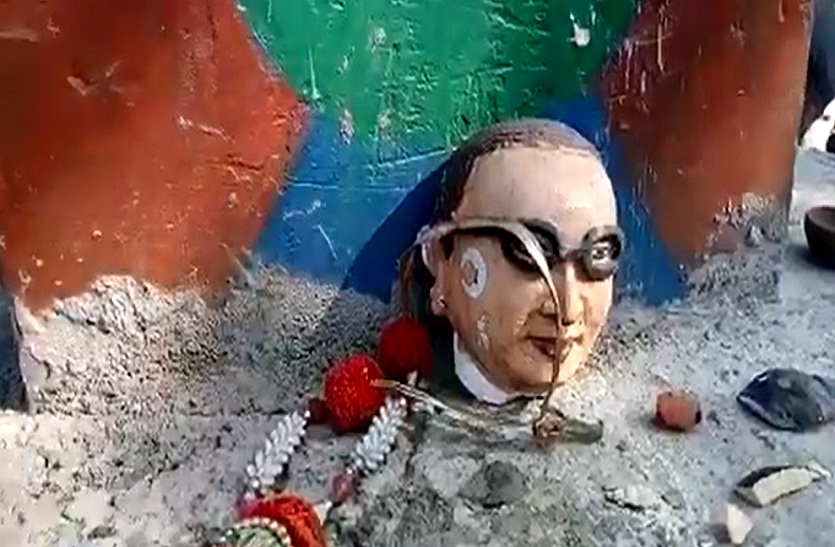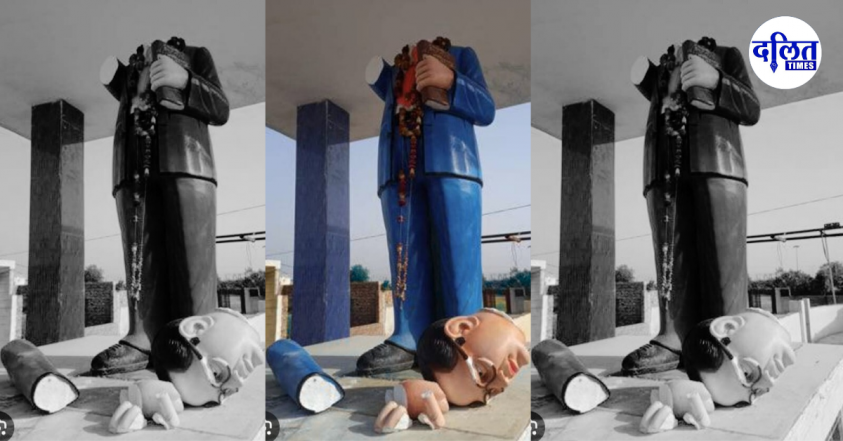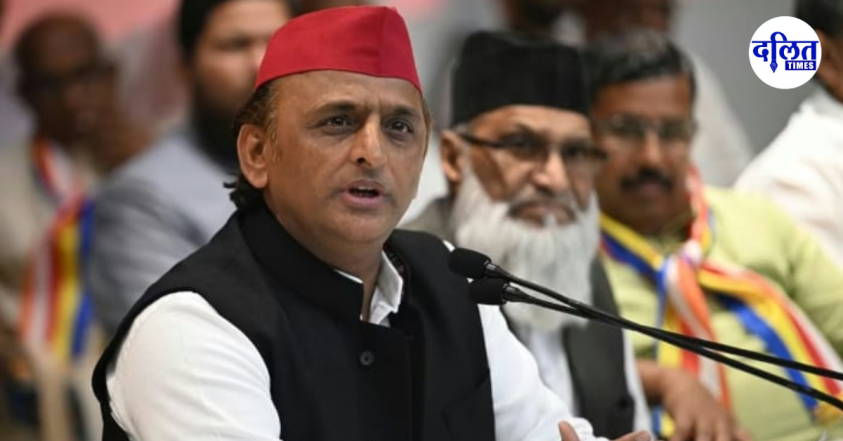From rural intersections to urban memorials, Ambedkar statues are being dismembered, smeared, set ablaze, or doused in oil. Each act is an act of counter-memory—an attempt to erase what Ambedkar symbolizes: social justice, radical equality, and annihilation of caste.
The hammering of Dr. B.R. Ambedkar’s statue in Amritsar on Republic Day was not merely an act of vandalism. It was a brazen assault on the conscience of the Indian Constitution — and the ripples are being felt far beyond Punjab. The incident has unearthed a troubling and recurrent reality: the targeted desecration of Ambedkar’s iconography, particularly in Uttar Pradesh, where such acts are no longer exceptional and they are habitual.
In a rare gesture that blurs state borders, Uttar Pradesh’s Social Welfare Minister Asim Arun led a cross-state fact-finding mission to the site of desecration in Amritsar. This high-powered delegation of bureaucrats, intelligence officers, and political advisors visited the heritage pathway where the statue of Ambedkar was struck with a hammer by Akashdeep Singh—an act meticulously recorded and virally circulated.
Also Read : FEDO at Three Decades: Power, Participation, and the Continuing Fight for Dalit Women’s Rights in Nepal
But this incident, shocking as it is, is not a singular aberration. It belongs to a pattern—a grim tableau of deliberate provocations, often timed around national observances like Republic Day, Constitution Day, or Ambedkar Jayanti. The pattern is unmistakable and increasingly insidious.
A Ritual of Desecration: Uttar Pradesh’s Broken Statues and Broken Promises
From rural intersections to urban memorials, Ambedkar statues are being dismembered, smeared, set ablaze, or doused in oil. Each act is an act of counter-memory—an attempt to erase what Ambedkar symbolizes: social justice, radical equality, and annihilation of caste.
Noteworthy Incidents, 2023–2025:
- Ballia (January 2025): In Chaube Chhapra village, Ambedkar’s bust was drenched in motor oil. The statue stood defiled for hours before a local outcry forced police action.
- Lucknow – BBD Area: A statue adjacent to Rajwada Lawn was smashed, its face disfigured. The government replaced it promptly—but offered no clarity on the motive or the accused.
- Budaun (2024): Ujhani’s Ambedkar Park became a battleground of memory. The statue was vandalized; community members protested with Ambedkar’s portrait garlanded in defiance, as the administration installed fresh CCTV equipment.
- Kaushambi (November 2023): On Constitution Day, the statue in Chitta Harayapur was deliberately fractured. Police cited “festive noise” as a reason for missing the incident.
- Muradnagar, Ghaziabad (December 2023): In Suthari village, the statue’s hands were broken. Community leaders alleged upper caste provocation, but FIRs were filed vaguely against “unknown persons.”
- Late 2024: Clarion India reported five desecration cases across UP in just eight weeks. The pattern is no longer statistical noise—it is a strategy.

- Azamgarh (August 2019): Three statues were vandalized the same night in Mirza Adampur, Sirkantpur, and Barmanpur. The symbolism was clear—widespread, coordinated desecration.
- Meerut (March 2018): In Chhota Mawana, after a statue was damaged, local Dalits took to the streets, blockading highways and chanting Ambedkar’s name into the heart of state indifference.
- Allahabad (Jhunsi, March 2018): A statue was beheaded. The decapitation, and the deafening silence that followed, exposed the moral anemia of local authorities.
Not Just Bronze and Cement: Assaults on Constitutional Morality
Each defaced Ambedkar statue is not a damaged object—it is a deliberate rupture in the social contract. These attacks are laced with caste hostility and infused with ideological violence. They target not just Ambedkar’s image but his imagination of India: a republic anchored in equality.
To the Bahujan communities, the statues are not lifeless memorials. They are breathing declarations of resistance. Their desecration is perceived not as mere vandalism but as public lynching of dignity.
“They break our icons to break our confidence,” said a Dalit activist from Ballia. “Every statue they damage is a message—they are reminding us that this is still their republic.”
Political Optics or Meaningful Action?
The Amritsar delegation led by Asim Arun appears to be a strategic gesture—both damage control and political signaling. It also reflects the political capital Ambedkar now commands, even among parties traditionally averse to caste-based mobilization.

But critics argue that the focus on Amritsar diverts attention from the festering crisis within Uttar Pradesh itself. The desecrations in UP have occurred under its nose, with little follow-up, meager arrests, and rare convictions.
Indeed, surveillance cameras and replacement statues may soothe public anger, but they do little to address the deeper malaise—a culture where caste hate is banal, emboldened, and increasingly visible.
A Call for Constitutional Vigilance
Ambedkar’s statues are being targeted because his ideas are still feared. Because his challenge to Brahminical supremacy remains potent. Because the Republic he envisioned has not yet been realized.
This is a moment of reckoning. Will India protect the visible expressions of its constitutional morality, or will it allow them to be desecrated piece by piece? Will it criminalize hate, or merely respond to it when it becomes inconvenient?

If a republic cannot safeguard its symbols, how can it claim to uphold its soul?
“The repeated attacks on Babasaheb Ambedkar’s statues are not acts of mischief — they are targeted assaults on the soul of the Constitution and the dignity of the Bahujan movement. That such incidents continue to erupt, from Uttar Pradesh to Punjab, especially on national days like Republic Day, is a damning indictment of those in power who have failed to uphold constitutional values. These are not failures of law and order alone — they reflect the wilful silence and complicity of governments that turn a blind eye to casteist provocations.”
“Parties like the BJP, Congress, and AAP shamelessly drape themselves in Ambedkar’s name during elections, yet when his statues are desecrated or his ideals betrayed, they vanish from the scene. Their commitment is hollow — they seek votes, not justice. If they truly respected Babasaheb, they would have honoured him in his lifetime, not turned his legacy into a token for political spectacle.”
Also Read : “This Is Not Justice — It’s Caste Control:, The Criminalization of Vedan a Dalit Rapper”
“I demand the strongest possible legal action — not just minor charges, but serious provisions that reflect the gravity of these crimes. These are attacks driven by caste hatred, intended to provoke and divide. The state must act with urgency and purpose, or its silence will only embolden those who seek to erase Ambedkar from public memory.”
“For us in the Bahujan Samaj Party, Ambedkar is not a statue to be garlanded for a photo — he is the foundation of justice, dignity, and self-respect. Every broken statue is a warning: that our democracy remains fragile, and that the struggle for equality is far from over.” The chief of BSP- Mayawati.
The assaults on Ambedkar statues are not episodes of mindless destruction. They are coded messages, political statements, and ideological provocations. Whether driven by caste supremacy, right-wing radicalism, or administrative inertia, the result is the same: the erosion of India’s moral core.
Bindu Ammini, Dalit Feminist



